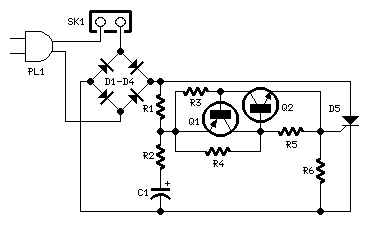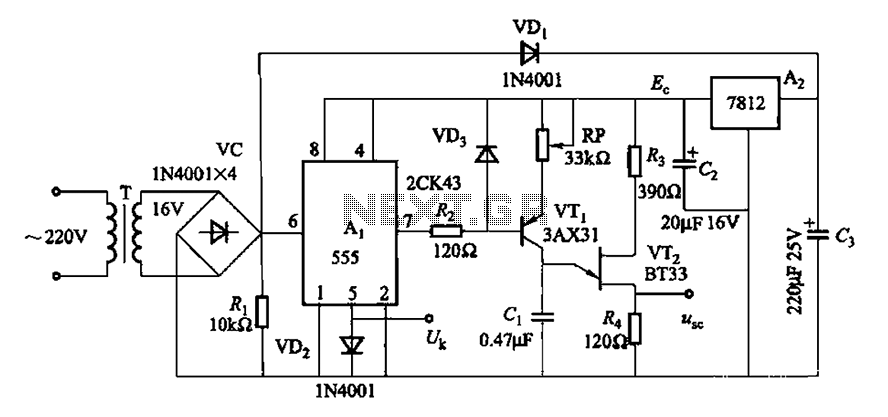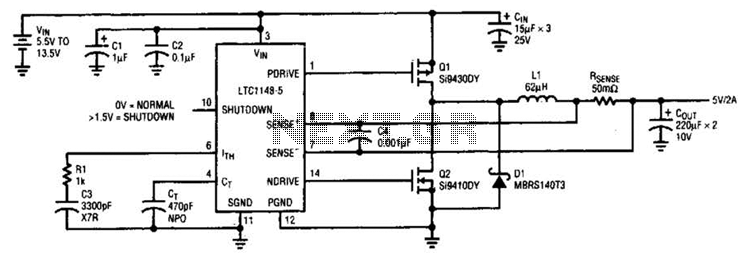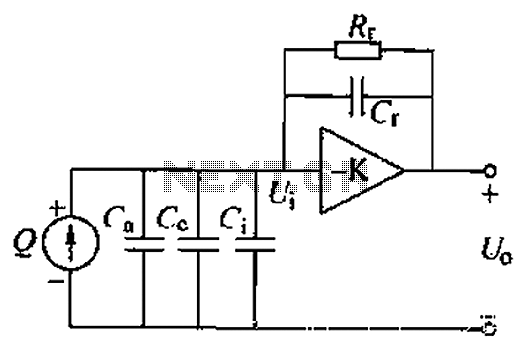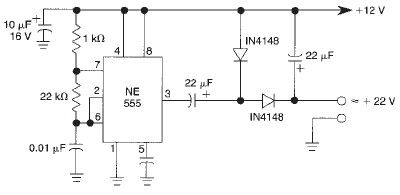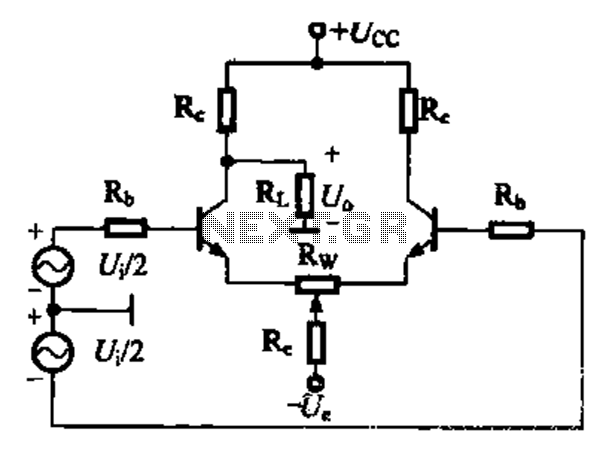
Clap Switch circuit diagram
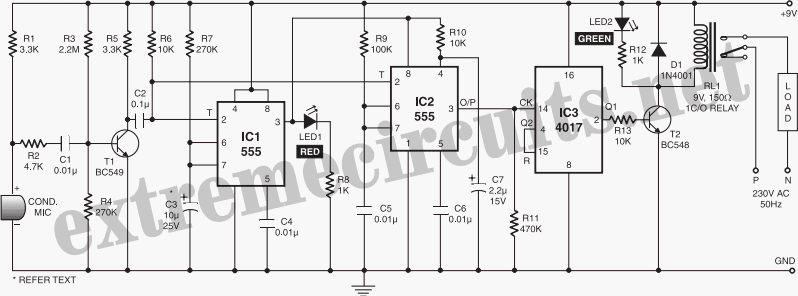
This is a clap switch designed to avoid false triggering. To activate or deactivate any appliance, a user must clap twice. The circuit changes its output state only when two claps are detected within a specified time frame of 3 seconds. The clap sound is captured by a condenser microphone and amplified by transistor T1. The amplified signal generates a negative pulse to pin 2 of IC1 and IC2, triggering both integrated circuits. IC1 is configured as a monostable multivibrator, commonly used as a timer. When triggered, the output pin 3 of IC1 goes high and remains in this state for a duration determined by the resistor R7 and capacitor C3 values. The on-time (T) of IC1 can be calculated using the formula T = 1.1 * R7 * C3 seconds, where R7 is in ohms and C3 is in microfarads. Upon the first clap, the output pin 3 of IC1 goes high and stays in this standby position for the preset duration, during which LED1 illuminates. The output from IC1 supplies voltage to IC2 at pins 8 and 4, preparing IC2 to receive the triggering signal. Resistor R10 and capacitor C7 connected to pin 4 of IC2 help prevent false triggering when IC1 initially powers IC2. Upon the second clap, a negative pulse triggers IC2, causing its output pin 3 to go high for a time period based on R9 and C5. This generates a positive pulse at clock pin 14 of the decade counter IC 4017 (IC3). IC3 is configured as a bistable device, where each pulse at clock pin 14 alters the output state at pin 2 (Q1) of IC3, since Q2 is connected to reset pin 15. The high output at pin 2 activates transistor T2, energizing relay RL1. LED2 indicates the activation of relay RL1 and the on/off status of the connected appliance. A free-wheeling diode (D1) is included to protect T2 from back EMF when the relay de-energizes.
The clap switch circuit utilizes a combination of analog and digital components to effectively respond to sound input. The condenser microphone serves as the primary sensor, converting acoustic energy from claps into an electrical signal. This signal is then amplified by transistor T1, ensuring that even soft claps are detected reliably. The design incorporates two integrated circuits, IC1 and IC2, which are crucial for timing and triggering functions. IC1's monostable configuration ensures that the circuit remains responsive only for a defined period after the first clap, thus preventing accidental activation from extraneous noise.
The timing elements, R7 and C3, are selected based on the desired response time. The relationship between resistance and capacitance allows for flexibility in tuning the circuit to specific applications. The second clap triggers IC2, which is responsible for generating the output that activates the relay. The decade counter IC 4017 is utilized in a bistable mode to maintain the state of the relay, providing a stable on/off control for the connected appliance.
The use of a free-wheeling diode (D1) is essential in inductive load applications, as it protects the transistor from voltage spikes caused by the collapsing magnetic field of the relay coil. This safeguard enhances the longevity and reliability of the circuit. Additionally, the inclusion of indicator LEDs (LED1 and LED2) provides visual feedback to the user, confirming the operational status of the system. Overall, this clap switch design is an efficient and user-friendly solution for remote control of electrical devices, leveraging simple yet effective electronic principles.Here`s a clap switch free from false triggering. To turn on/off any appliance, you just have to clap twice. The circuit changes its output state only when you clap twice within the set time period. Here, you`ve to clap within 3 seconds. The clap sound sensed by condenser microphone is amplified by transistor T1. The amplified signal provides negat ive pulse to pin 2 of IC1 and IC2, triggering both the ICs. IC1, commonly used as a timer, is wired here as a monostable multivibrator. Trigging of IC1 causes pin 3 to go high and it remains high for a certain time period depending on the selected values of R7 and C3. This on` time (T) of IC1 can be calculated using the following relationship: T=1. 1R7. C3 seconds where R7 is in ohms and C3 in microfarads. On first clap, output pin 3 of IC1 goes high and remains in this standby position for the preset time.
Also, LED1 glows for this period. The output of IC1 provides supply voltage to IC2 at its pins 8 and 4. Now IC2 is ready to receive the triggering signal. Resistor R10 and capacitor C7 connected to pin 4 of IC2 prevent false triggering when IC1 provides the supply voltage to IC2 at first clap. On second clap, a negative pulse triggers IC2 and its output pin 3 goes high for a time period depending on R9 and C5.
This provides a positive pulse at clock pin 14 of decade counter IC 4017 (IC3). Decade counter IC3 is wired here as a bistable. Each pulse applied at clock pin 14 changes the output state at pin 2 (Q1) of IC3 because Q2 is connected to reset pin 15. The high output at pin 2 drives transistor T2 and also energizes relay RL1. LED2 indicates activation of relay RL1 and on/off status of the appliance. A free-wheeling diode (D1) prevents damage of T2 when relay de-energizes. 🔗 External reference
The clap switch circuit utilizes a combination of analog and digital components to effectively respond to sound input. The condenser microphone serves as the primary sensor, converting acoustic energy from claps into an electrical signal. This signal is then amplified by transistor T1, ensuring that even soft claps are detected reliably. The design incorporates two integrated circuits, IC1 and IC2, which are crucial for timing and triggering functions. IC1's monostable configuration ensures that the circuit remains responsive only for a defined period after the first clap, thus preventing accidental activation from extraneous noise.
The timing elements, R7 and C3, are selected based on the desired response time. The relationship between resistance and capacitance allows for flexibility in tuning the circuit to specific applications. The second clap triggers IC2, which is responsible for generating the output that activates the relay. The decade counter IC 4017 is utilized in a bistable mode to maintain the state of the relay, providing a stable on/off control for the connected appliance.
The use of a free-wheeling diode (D1) is essential in inductive load applications, as it protects the transistor from voltage spikes caused by the collapsing magnetic field of the relay coil. This safeguard enhances the longevity and reliability of the circuit. Additionally, the inclusion of indicator LEDs (LED1 and LED2) provides visual feedback to the user, confirming the operational status of the system. Overall, this clap switch design is an efficient and user-friendly solution for remote control of electrical devices, leveraging simple yet effective electronic principles.Here`s a clap switch free from false triggering. To turn on/off any appliance, you just have to clap twice. The circuit changes its output state only when you clap twice within the set time period. Here, you`ve to clap within 3 seconds. The clap sound sensed by condenser microphone is amplified by transistor T1. The amplified signal provides negat ive pulse to pin 2 of IC1 and IC2, triggering both the ICs. IC1, commonly used as a timer, is wired here as a monostable multivibrator. Trigging of IC1 causes pin 3 to go high and it remains high for a certain time period depending on the selected values of R7 and C3. This on` time (T) of IC1 can be calculated using the following relationship: T=1. 1R7. C3 seconds where R7 is in ohms and C3 in microfarads. On first clap, output pin 3 of IC1 goes high and remains in this standby position for the preset time.
Also, LED1 glows for this period. The output of IC1 provides supply voltage to IC2 at its pins 8 and 4. Now IC2 is ready to receive the triggering signal. Resistor R10 and capacitor C7 connected to pin 4 of IC2 prevent false triggering when IC1 provides the supply voltage to IC2 at first clap. On second clap, a negative pulse triggers IC2 and its output pin 3 goes high for a time period depending on R9 and C5.
This provides a positive pulse at clock pin 14 of decade counter IC 4017 (IC3). Decade counter IC3 is wired here as a bistable. Each pulse applied at clock pin 14 changes the output state at pin 2 (Q1) of IC3 because Q2 is connected to reset pin 15. The high output at pin 2 drives transistor T2 and also energizes relay RL1. LED2 indicates activation of relay RL1 and on/off status of the appliance. A free-wheeling diode (D1) prevents damage of T2 when relay de-energizes. 🔗 External reference
